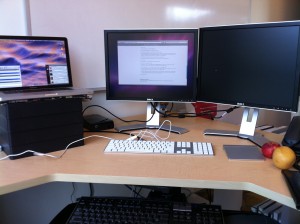I’m currently on vacation in Australia. I’ve been here several times before, and lived here for a few months in 2000/2001. This time, I’m here with my husband, visiting his family for the holidays. We’ve been to Melbourne, driven the Great Ocean Road, seen the Grampians1, and are now back in Sydney for the remainder of the trip2.
Shopping here, or rather completing a purchase here, is quite different than what I’m used to. In the States, when I use my credit card, it’s almost unheard-of for the salesperson to compare my signature on the paper with that on my credit card. I’ve made quite expensive purchases at home, such as furniture or a computer, and not had my signature or identification checked. I’m almost never asked whether I’m using a debit card or credit card. Here, the credit or debit card is the first one asked, and I have to remember to just hit the OK button instead of entering a PIN. Likewise, every single salesperson checks my signature, no matter how small the transaction. Yesterday, I was in a grocery store purchasing drinks, and the self-checkout didn’t accept cash. So I put the five bucks on my card, and someone still came over to check my signature!
This is all pretty minor, and is never a big deal. It does show how well I’ve been trained in the US shopping experience. But this week, shopping in Myer (a large department store), I found a user experience in shopping that ticked me off. I tried to purchase a hat, having an ability to sunburn that’s unequalled by mere mortals. At the checkout, I swiped my credit card. After not entering my PIN, I was then presented with a statement of how much that this would cost in US$, and asking me to hit OK to accept this and CLEAR to not accept it. So I hit OK. Then I got the receipt, where they were actually charging me in US$ instead of letting my bank do the conversion. I wouldn’t mind this if their exchange rate wasn’t so bad, and if they weren’t charging me a 2.5% commission to boot.
Aside from the exchange rate and the commission that isn’t disclosed in advance, this is a really bad user experience. I don’t mind that they detected that my credit card is American. When Myer’s credit card machine showed me the US$ amount, I thought that it was simply a courtesy, and that hitting CLEAR was giving me an opportunity to back out of a transaction if I didn’t realise how expensive an item was after the conversion. The question is worded poorly on-screen. What I learnt later, only through trial and error, was that hitting CLEAR actually results in a charge in the local currency instead of my home currency, and thus my bank will do the conversion.
As a shopper, we’re well-trained to hit OK on all prompts. CLEAR is a button that you only hit in the case of an error on your part, such as accidentally entering an incorrect number in your PIN. You never move forward in a transaction by hitting CLEAR. Overloading CLEAR in this case results in additional confusion.
Furthermore, Myer appears to be the only shop doing this, so the purchasing experience is completely inconsistent with what happens when I purchase something in other shops. Their salespeople have no idea what the credit card machine is trying to communicate to me, either. The one who rang up the hat tried to tell me that I’d been charged in AU$ instead of US$. Of course, the receipt wasn’t exactly clear about what was happening either, so I can’t blame her for being confused by it.
Overall, the experience left a really bad taste in my mouth. Between the bad exchange rate and the commission, it feels like they’re taking advantage of tourists. I have to wonder what happens to the large number of Japanese tourists that I’ve seen in Melbourne and Sydney, who might not fully understand the English on the receipt. This experience with Myer has resulted in me skipping their stores entirely, and simply shopping at David Jones instead.
Before I left America, I researched my existing credit cards to learn which one had the best fee for purchases overseas. In the course of this research, I discovered that some other credit cards had changed their fees since I last looked, and found a few that don’t charge fees at all for overseas purchases. I ended up getting a new Visa card from PenFed, which both uses a fair exchange rate and has no fees for pretty much everything. Since I’m so happy with this credit card (their customer service has been exemplary so far, and the lack of fees has now made it the only card that I’m using here), I vastly prefer relying on them to handle my international purchases.
And no, I didn’t buy the hat. I went to David Jones and purchased one from a shop that I don’t feel like is actively trying to take advantage of tourists.
- Complete with a plague of locusts. ↩
- If you’re interested in what I’m seeing in Australia, I’m posting some pictures to twitter. I’m sure I’ll post the rest to Facebook when I get home. ↩
